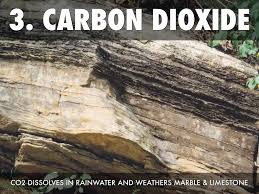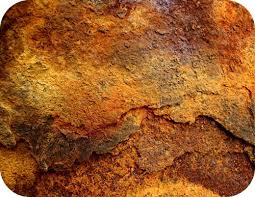Weathering is the process that changes solid rock into sediments. With weathering, rock is disintegrated into smaller pieces. Once these sediments are separated from the rocks, erosion is the process that moves the sediments away from it’s original position. The four forces of erosion are water, wind, glaciers, and gravity. Water is responsible for most erosion. Water can move most sizes of sediments, depending on the strength of the force. Wind moves sand-sized and smaller pieces of rock through the air. Glaciers move all sizes of sediments, from extremely large boulders to the tiniest fragments. Gravity moves broken pieces of rock, large or small, down slope. These forces of erosion will be covered later.While plate tectonics forces work to build huge mountains and other landscapes, the forces of weathering and mass wasting gradually wear those rocks and landscapes away, called denudation. Together with erosion, tall mountains turn into hills and even plains. The Appalachian Mountains along the east coast of North America were once as tall as the Himalayas.
No human being can watch for millions of years as mountains are built, nor can anyone watch as those same mountains gradually are worn away. But imagine a new sidewalk or road. The new road is smooth and even. Over hundreds of years, it will completely disappear, but what happens over one year? What changes would you see? What forces of weathering wear down that road, or rocks or mountains over time?
Mechanical Weathering
Mechanical weathering, also called physical weathering, breaks rock into smaller pieces. These smaller pieces are just like the bigger rock, just smaller. That means the rock has changed physically without changing its composition. The smaller pieces have the same minerals, in just the same proportions as the original rock.There are many ways that rocks can be broken apart into smaller pieces. Ice wedging, also called freeze-thaw weathering, is the main form of mechanical weathering in any climate that regularly cycles above and below the freezing point. Ice wedging works quickly, breaking apart rocks in areas with temperatures that cycle above and below freezing in the day and night, and also that cycle above and below freezing with the seasons.Ice wedging breaks apart so much rock that large piles of broken rock are seen at the base of a hillside called talus. Ice wedging is common in Earth’s polar regions and mid latitudes, and also at higher elevations, such as in the mountains. Abrasionis another form of mechanical weathering. In abrasion, one rock bumps against another rock.
- Gravity causes abrasion as a rock tumbles down a mountainside or cliff.
- Moving water causes abrasion as particles in the water collide and bump against one another.
- Strong winds carrying pieces of sand can sandblast surfaces.
- Ice in glaciers carries many bits and pieces of rock. Rocks embedded at the bottom of the glacier scrape against the rocks below.
- Abrasion makes rocks with sharp or jagged edges smooth and round. If you have ever collected beach glass or cobbles from a stream, you have witnessed the work of abrasion.
Now that you know what mechanical weathering is, can you think of other ways it could happen? Plants and animals can do the work of mechanical weathering. This could happen slowly as a plant’s roots grow into a crack or fracture in rock and gradually grow larger, wedging open the crack. Burrowing animals can also break apart rock as they dig for food or to make living spaces for themselves.
Mechanical weathering increases the rate of chemical weathering. As rock breaks into smaller pieces, the surface area of the pieces increases. With more surfaces exposed, there are more surfaces on which chemical weathering can occur.

Chemical Weathering
Chemical weathering is the other important type of weathering. Chemical weathering is different from mechanical weathering because the rock changes, not just in size of pieces, but in composition. That is, one type of mineral changes into a different mineral. Chemical weathering works through chemical reactions that cause changes in the minerals.Most minerals form at high pressure or high temperatures deep in the crust, or sometimes in the mantle. When these rocks reach the Earth’s surface, they are now at very low temperatures and pressures. This is a very different environment from the one in which they formed and the minerals are no longer stable. In chemical weathering, minerals that were stable inside the crust must change to minerals that are stable at Earth’s surface.Remember that the most common minerals in Earth’s crust are the silicate minerals. Many silicate minerals form in igneous or metamorphic rocks deep within the earth. The minerals that form at the highest temperatures and pressures are the least stable at the surface. Clay is stable at the surface and chemical weathering converts many minerals to clay. There are many types of chemical weathering because there are many agents of chemical weathering. Water is the most important agent of chemical weathering. Two other important agents of chemical weathering are carbon dioxide and oxygen.

Chemical Weathering by Water
A water molecule has a very simple chemical formula, H2O, two hydrogen atoms bonded to one oxygen atom. But water is pretty remarkable in terms of all the things it can do. Water is a polar molecule; the positive side of the molecule attracts negative ions and the negative side attracts positive ions. So water molecules separate the ions from their compounds and surround them. Water can completely dissolve some minerals, such as salt. Hydrolysis is the name of the chemical reaction between a chemical compound and water. When this reaction takes place, water dissolves ions from the mineral and carries them away. These elements have undergone leaching. Through hydrolysis, a mineral such as potassium feldspar is leached of potassium and changed into a clay mineral. Clay minerals are more stable at the Earth’s surface.
Chemical Weathering by Carbon Dioxide
Carbon dioxide (CO2) combines with water as raindrops fall through the atmosphere. This makes a weak acid, called carbonic acid. Carbonic acid is a very common in nature where it works to dissolve rock. Pollutants, such as sulfur and nitrogen, from fossil fuel burning, create sulfuric and nitric acid. Sulfuric and nitric acids are the two main components of acid rain, which accelerate chemical weathering.

Chemical Weathering by Oxygen
Oxidation is a chemical reaction that takes place when oxygen reacts with another element. Oxygen is very strongly chemically reactive. The most familiar type of oxidation is when iron reacts with oxygen to create rust. Minerals that are rich in iron break down as the iron oxidizes and forms new compounds. Iron oxide produces the red color in soils.Now that you know what chemical weathering is, can you think of some other ways chemical weathering might occur? Chemical weathering can also be contributed to by plants and animals. As plant roots take in soluble ions as nutrients, certain elements are exchanged. Plant roots and bacterial decay use carbon dioxide in the process of respiration.
